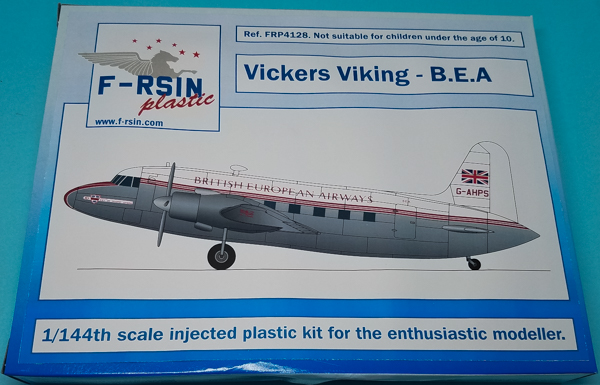
F-RSIN 1/144 Vickers Viking - B.E.A.
By Matt Bittner
Introduction
From Wikipedia:
"The Vickers VC.1 Viking is a British twin-engine short-range airliner derived from the Vickers Wellington bomber and built by Vickers-Armstrongs Limited at Brooklands near Weybridge in Surrey. After the Second World War, the Viking was an important airliner with British airlines, pending the development of turboprop aircraft like the Viscount. An experimental airframe was fitted with Rolls-Royce Nene turbojets and first flown in 1948 as the world's first pure jet transport aircraft. Military developments were the Vickers Valetta and the Vickers Varsity."
"BEA operated their large fleet of Vikings on many European and UK trunk routes for eight years. From 1951, the remaining fleet was modified with 36, instead of 27 seats, and named the "Admiral Class". BEA operated the Viking until late 1954, when the last was displaced by the more modern and pressurised Airspeed Ambassador and Vickers Viscount."
The Kit
The F-RSIN 1/144 Vickers Viking consists of 31 pieces of off-white, injected plastic and a decal sheet for ten different British European Airways (BEA) aircraft. Decals appear to be nicely printed and in register.
Construction will go quickly as there aren't a lot of parts. However, one thing to keep in mind is this is a short-run kit and the plastic is soft so you will need to clean all parts and the spure gates are large. There's a slightly rough texture to the overall plastic so smoothing the exterior is a must, especially if you finish the kit with any type of "Natural Metal Finish" (NMF).

|
There is no interior at all and in addition there are no clear parts, so at least you won't have to worry about masking those. All the "clear areas" on the kit are represented by decals. The engine representation isn't very robust so you may want to find an aftermarket engine to place inside. Or, like I plan on doing, just go with what is included.
Wheels are in halves so care must be taken to ensure they line up.
Glue together the fuselage halves and the wing halves (although the mating surfaces will need to be cleaned as well) then the pieces are all brought together to make an airframe. The cowls are separate, along with their upper scoop and exhausts, plus the "football" antenna on top of the fuselage is also a separate piece.
Once the landing gear legs are cleaned up then those are added to the model along with the assembled wheels. There are four main gear doors per side which can be added to the model along with the separate tail wheel/gear model part. As the final step - after adding the decals - the props are added resulting in a 1/144 Vickers Viking.
Conclusion
Even though there is some work involved, since it's a short-run kit, the F-RSIN Vickers Vicking still won't take long to assemble. Surface prep, painting and decaling will probably take the most time. I still recommend this kit as it's a very nice representation of the Viking.
I definitely thank F-RSIN for the review kit.
